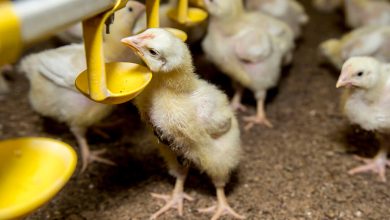Common Diseases of Cage Laying Hens

Prof. R.N.SreenivasGowda
Founder and Former Vice Chancellor, KVAFSU, Bidar, Karnataka
Poultry is one of the fastest growing segments of the agricultural sector in India today. India has emerged on the world map as the 2nd largest egg producer (88 billion eggs) and annual growth rate in egg production approximated 7-8 % per year (Source; Report of the Working Group on AH& dairying,). The current strength of layers in India is estimated to be 230 million and the annual percapita availability of eggs has increased from 7 eggs in 1961 to 68 eggs in 2015. However, the present availability is far below then the ICMR recommendation of 180 eggs per capita per annum.
The poultry sector in India has undergone a paradigm shift in structure and operation. This transformation has involved sizable investments in breeding, hatching, modernization in rearing and adoption of latest processing echniques . Farmers in India have adopted for rearing hybrids which ensures faster growth, good liveability, excellent feed conversion, high egg production and profits to the poultry farmers. High quality chicks, equipment, vaccines and medicines are now available through both public and private players. Technically and professionally competent guidance is available to the farmers. The managerial practices have improved and disease and mortality incidences are reduced to a great extent. This is all possible due to adoption to new technologies available.
Cage system of rearing of poultry is very common and popular among Indian poultry. Caged layers and breeders are also prone to several diseasesif proper attention in management, nutrition and healthcare is not practiced properly. The breeders reared in cages,artificial insemination(AI) is practiced. These birds are handled by inseminators in cages. Such birds are more prone to cloacal and genital problems therefore, at most sanitary and managemental care need to be exercised.
Egg industry in India is flourishing because of cage system of rearing is practiced. In recent years cages have generated controversy by for animal rights personnel and industrial producers.
What is Cage system ?
Cage system is primarily used for egg-laying hens and in breeders. In this system of rearing birds has been considered as a super intensive system providing floor area of 450-525 sq.cm. (0.6-0.75sq.feet) per bird. The cages are made by galvanized wire and the birds are kept in one, two or three per cage, arranged in single or double or triple rows in a house.
What is Battery Cage ?
The name Battery Cage arises from the arrangement of rows and columns of identical cages connected together, in a unit, as in an artillery battery and hence the name battery cage.
What are the advantages and disadvantages of laying cages ?
Advantages
1. More birds may be reared per unit of area
2. Facilitates correct maintenance of records
3. Easy toidentify poor producers and prompt culling
4. Control of vices of poultry cannibalism and egg eating
5. Production of cleaner eggs
6. Easy control of protozoan diseases and worm infestation.
7. Helps to control feed wastage.
8. Ideal formoderated climate conditions.
9. Less feed is required to produce a dozen eggs
10. Better Feed efficiency and egg weight
11. Labor requirements are generally much reduced
Disadvantages
1. The handling of manure may be a problem.
2. Generally, flies become a greater nuisance.
3. The investment per pullet may be higher than in the case of floor operations.
4. There is a slightly higher percentage of blood spots in the eggs.
5. The bones are more fragileand Cage layer fatigue problem may arise.
6. Difficult in ensuring proper ventilation to birds especially in summer season and under very high denser conditions.
7. Hysteria is common in cage rearing.
What are the Common Diseases of Cage Layers?
The common diseases in caged poultry may be classified as follows:
Physical damage: broken legs, wings, cannibalism and cutaneous aberrations due to sharp claws and due to hysterical disturbance in the flock. Restricted movement in cages with lack of exercise, the birds aremore prone to metabolic disorders.
Chemical /nutritional: Chemical toxins, nutritional imbalance -Cage layer fatigue are some of thenutritional problems.
Biological:Bacterial, Viral and Parasitic infections if not protected properly.
Further, the Cage layer diseases can be classified in to Non Infectious and Infectious diseases:
I. Non Infectious diseases
1. Bone disorder/ fragility
Bone fragility and increased fat content in the liver of egg-laying hens are more often encountered in birds from traditional battery-cage systems than in those confined in other systems. Bone fragility can be seen either as a general weakness of bone tissue or as a clinically manifest disease, Cage layer fatigue. It is concluded, that general restriction of the Birds possibilities to locomotive and perform comfort movements are the most important aetiologicalfactors. Improper mixing of feed additives or inadequate supply of Vitamin D3, Calcium and phosperous are attributable factors for cause of Cage Layer Fatigue. Lack of movements and depletion of bone Calcium in high egg producer breeds is the cause for bone fragility.
2. Fatty liver disease
Fatty liver syndrome occurs through accumulating too much fat in the liver of a hen. Hemorrhage of liver due to rupture of liver and death are the postmortem features of this disease. The affected hens have pale combs and a big blood clot in the abdomen. Feeds containing too much carbohydrates can results much fat in laying hens.
It can prevented by providing nutritious feed, good housing, fresh water and good management.The condition maybe seen either as a pathological elevation of the liverfat content or it may be seen as a disease called Fatty liver haemorrhagic syndrome. Several factors may cause elevation of the liver fat content. The influence of restricted movement on the birdsin cage system, energy balance, and behavioural disturbances seems to be the most important aetiological factors.
3. Egg Eating
Egg eating is one of the major vice with cage laying hens. Inadequate water supply due to clogged nipples, or dehydration due to hot water in summer months initiates egg eating ahabit.There are many reasons of eggs disappearing from the cages . If eggs disappear, snakes or other predators/ attenders might bestealing them also need to be identified.
Egg eating vice starts when the hen taste the contents of a broken egg. Once tasted they will continue to eat their own eggs. And it’s very difficult to stop this habit once started. So it’s very important to prevent hens from eating their own eggs. It is easy to diagnose as there will be more broken shells at the bottom of such cages.
The solution is frequent collection of fresh eggs from the cages( two or three times daily) Installing quality water nipplesto avoid clogging and to prevent accidental breakage of eggs by safeguarding with sponge padding.
4. Molting
Feather losing and new feather producing process is known as molting. Laying hens usually stop producing eggs during their molting period. Naturally laying hens begin molting in late summer or during early autumn. Some chickens start molting at their 4 months of age and some chickens don’t molt until they reach at least one year of age. Depending on the breeds, molting process can take few weeks even months. Once the hens complete their molting cycle, they will start laying eggs again.
5. Caged Layer Fatigue(CLF)
CLF is a metabolic disease of poultry. Especially laying hens suffers much due to lack of proper amount of phosphorus and calcium ratio. If any hen which is alert but unable to move, then it might be suffering from caged layer fatigue. If not treated timely, itmight die by dehydration. Separate the affected birds to another cage and supply fresh water and quality feed. By providing balanced Vitamin D,calcium and phosperous will help avoiding further instances of diseases in the flock. Raising the flock in free range or deep litter system can be helpful for preventing the disease.
6. Rickets
Rickets disease due to lack of vitamin D or improper ratio of calcium and phosphorus in their regular feed chacterarised by soft and bowed bones, thin shelled eggs, lameness, fractured limbs, low egg production etc. are symptoms of this disease. If the feed is well balanced, then chances of getting affected by rickets disease is less. Because most of the commercial layer feed contain proper ratio of all the necessary nutrients, the chances of getting rickets is minimal.
7. Stops Laying Eggs
Sometimes the laying hens stop laying eggs for numerous reasons. The laying hens need about 14 to 16 hours of lighting period daily for producing normal number of eggs . Along with the sunlight, use artificial lighting is required by using a 40 watt bulb for every 100 squire feet flooring space, and extending the hours of lighting depending on the season of available lighting encourage them to lay eggs again. Feeding habit also affects the egg laying of hens. Errors in feeding schedule and quality nutrition cause drop in production. Laying hens require sufficient amount of fresh and nutritious feed. They need about 16 to 18 percent protein in the feed. Also require adequate amount of essential vitamins and minerals with their regular feed.
8. Hysteria or Flightiness.
Normally, hysteria would originate from one point in the cage house or shed and spread out in all direction. Birds seem to lose all normal social behaviour and sense of direction and will mill (crash) and fly in every direction of the cage and making unusual crying with squawking sounds. Production drop is observed more in such caged houses.Controlling multifactorial factors and providing high levels of methionine (2kg/tonne), niacin (200 g/tonne supplement) or tryptophan (up to 5 kg/ tonas feed supplement) or in drinking water. Adding meat meal or fish meal supplementin increased the levels in the diet will reduce the incidence.
II. Infectious Diseases
Infectious diseases spread quickly in cage system of rearing because of high density and close proximity of flock. The some of the common diseases are as follows:
1. Egg Drop Syndrome–(EDS-76)
The classical Egg drop syndrome is caused by adenoviral viral infection in laying hens transmitted vertically from hens to chicks. The virus is often latent until the chicks reach maturity, thereafter, the matured chickens begin to excrete virus and transmit through the eggs and droppings and infect to a healthy hens and virus can pass from asymptomatic hen to other birds. The disease is characterised by sudden drop (10-40%) in egg production or a failure to achieve a normal peak in production. Production of soft-shelled which easily break and shell-less eggs in apparently healthy birds, Intermittent diarrhea is one of the first signs of egg drop syndrome. The other clinical signs of infection are loss of color in pigmented eggs and soft-shelled, thin-shelled, and shell-less eggs. Thin-shelled eggs may have a rough or even sandpaper-like surface. Sometimes the laying hen can stop laying eggs for a certain period. It is thought that, egg drop syndrome transfer through the contaminated vaccine manufactured out of non SPF eggs.Prevention is adopting proper biosecurity practices. A killed vaccine can be given during the pullet-rearing phase to help prevent the disease.
2. Marek’sdisease .
Marek’s disease is contagious Herpes virus infection of chickens. In endemic areas there is often poor production is observed in cage system because of cancerous and nonproductive ovaries. The route of infection is usually respiratory and the disease is highly contagious being spread by infective feather-follicle dander, fomites, etc. Infected birds remain viraemic for life. The disease is characterized by T-Cell lymphomas of all visceral organs and peripheral nerve enlargement. The disease may be noticed up to seventy week and above age birds. The standard criteria of diagnosis includes, history, clinical signs of emaciation, pale comb, gross necropsy, and histopathology. Although no treatment is available, current vaccines are highly protective.
Vaccines are administered at hatch or in ovo to embryos at the 18th day of incubation. In ovo vaccination is now performed by automated technology and is widely used for vaccination of commercial chickens, mainly because of reduced labor costs and greater precision of vaccine administration.
The disease may become a serious problem in individual flocks or in selected geographic areas .
3. Lymphoid leukosis (LL)
Lymphoid is a neoplastic disease of poultry caused by avian leukosis virus. The disease is characterized by B-cell lymphoma, occurring in chickens approximately 16 weeks of age and older. Chickens with lymphoid leukosis have few typical clinical signs. These may include inappetence, weakness, diarrhea, dehydration, and emaciation. Infected chickens become depressed before death. Palpation often reveals an enlarged bursa and sometimes an enlarged liver. Infected birds may not necessarily develop tumors, but they may lay fewer eggs. Diagnosis is based on history and clinical signs, gross pathology, and histopathology, immune-histochemistry, standard and quantitative PCR, virus isolation and serology. There is no treatment or vaccine available, so eradication of avian leukosis viruses from breeding flocks is the most effective control method.
4. Newcastle disease(ND/RD/VVND)
Newcastle or Ranikhet disease is an acute viral infection of domestic poultry and other bird species with virulent Newcastle disease virus (NDV). It is a worldwide problem that presents primarily as an acute respiratory disease, but depression, nervous manifestations, or diarrhea may be the predominant clinical form.
An infected bird may exhibit several signs, including respiratory signs (gasping, coughing), nervous signs (depression, inappetence, muscular tremors, drooping wings, twisting of head and neck, circling, complete paralysis), swelling of the tissues around the eyes and neck, greenish, watery diarrhea, misshapen, thin shelled eggs. The virus can remain alive in manure for up to 2 months and in dead carcasses for up to 12 months, however it is easily killed by disinfectants, fumigants and direct sunlight. Prevention relies on good quarantine and biosecurity procedures and vaccination.
5. Avian infectious bronchitis (IB)
IB is an acute and highly contagious respiratory disease of chickens. The disease is caused by avian infectious bronchitis virus (IBV), a corona virus, and clinically characterized by respiratory signs such as gasping, coughing, sneezing, tracheal rales, and nasal discharge.in young chicks.
Clinical signs are strongly dependent on the tropism (preferred tissue to infect) of the strain. Loss of appetite , wet litter and Feed intake decreases sharply with minimal mortality in older birds. Some of the IB strains cause damage to the development of oviduct and they become “False Layers” ends up either egg peritonitis or useless pullets.Less common strains can cause a sharp drop in egg production in layers, and production usually drops to near zero within a few days. Recovery occurs within 3 – 4 weeks, however some flocks never regain an economical rate of lay. During an outbreak, small, soft-shelled, irregular-shaped eggs are produced. Decreased egg production and egg quality are common, and nephritis can be caused by some strains.
Diagnosis relies on viral isolation and characterization. For virus characterization, recent methodology using genomic amplification (PCR) and sequencing of products, will enable very precise description of strains, according to the oligonucleotide primers designed and target gene. Methods for IBV antigens detection may employ labeled antibodies, such as direct immunofluorescence or immunoperoxidase. Antibodies to IBV may be detected by indirect immunofluorescent antibody test, ELISA and Haemagglutination inhibition test.Prevention by vaccines represents a modified or selected strain of the infectious bronchitis virus and therefore the vaccine used should contain specific virus known to be present in the area. All vaccines contain live virus and those that give the best protection unfortunately can also produce clinical signs of disease and the vaccine virus will spread to other susceptible birds. Vaccine is usually added to the drinking water, but may be dropped into the eye or nostril or used as a spray.
6. Infectious laryngotracheitis(ILT)
ILT is an acute, highly contagious, herpesvirus infection of chickens characterized by severe dyspnea, coughing, and rales. It can also be a subacute disease with nasal and ocular discharge, tracheitis, conjunctivitis, and mild rales. The disease is caused by Gallidherpesvirus I, commonly known as infectious laryngotracheitis virus (ILTV).In the acute form, gasping, coughing, rattling, and extension of the neck during inspiration are seen 5–12 days after natural exposure. Reduced productivity is a varying factor in laying flocks. Affected birds are anorectic and inactive. The mouth and beak may be bloodstained from the tracheal exudate. Mortality varies but may reach 50% in adults and is usually due to occlusion of the trachea by hemorrhage or exudate. Signs usually subside after 2 wk, although some birds may show signs for longer periods. Strains of low virulence produce little or no mortality with mild respiratory signs and a slight decrease in egg production. Laboratory diagnosis is required for ILT, because other diseases cause similar clinical signs and lesions, such as infectious bronchitis, Newcastle disease, avian influenza, infectious coryza, and mycoplasmosis. ILTV infection can be confirmed using several methods, including virus isolation and DNA detection. For ILTV isolation, the CAM inoculation of 9-to-12-d-old embryos and primary cell culture are used.
The disease is controlled by implementation of biosecurity measures and vaccination. Vaccination is done with live attenuated vaccines and viral vector recombinant vaccines. Live vaccines originated from virulent isolates that were attenuated by consecutive passages in embryos or tissue culture.
7. Avian influenza
This is a notifiable viral diseaseand caused by Avian Influenza virus A that causes coughing, depression, anorexia, egg drop, cyanosis of the combs and wattles, diarrhoea, ocular and nasal discharge, and death.Avian influenza A viruses are classified into the following two categories: low pathogenic avian influenza (LPAI) A viruses, and highly pathogenic avian influenza (HPAI) A viruses. Infection of poultry with LPAI viruses may cause no disease or mild illness (such as ruffled feathers and a drop in egg production) and may not be detected. Infection of poultry with HPAI viruses can cause severe disease with high mortality. Both HPAI and LPAI viruses can spread rapidly through poultry flocks.
Avian influenza outbreaks are of concern in domesticated birds for several reasons:
• the potential for low pathogenic H5 and H7 viruses to evolve into highly pathogenic viruses
• the potential for rapid spread and significant illness and death among poultry during outbreaks of highly pathogenic avian influenza
• the economic impact and trade restrictions from a highly pathogenic avian influenza outbreak
• the possibility that avian influenza A viruses could be transmitted to humans
The diagnosis of avian influenza (AI) virus infections, even highly pathogenic AI (HPAI), represents a considerable challenge due to the lack of pathognomonic or specific clinical signs and their variation in different avian hosts plus the marked antigenic variation amongst influenza A viruses. There is an overwhelming demand for rapid results. More and more, molecular biological techniques are being used and in particular reverse transcriptase-polymerase chain reaction (RT-PCR) and real-time RT-PCR technologies are being employed for rapid diagnosis. The affected birds have to be destroyed to control the spread. Infected birds can shed avian influenza A viruses in their saliva, nasal secretions, and feces. Susceptible birds become infected when they have contact with the virus as it is shed by infected birds. They also can become infected through contact with surfaces that are contaminated with virus from infected birds.
8 Wing Rot /Gangrinous dermatitis(GD):
GD is also known as “gangrenous cellulitis,” “wing rot” or “red leg.” GD usually starts with the appearance of aberrations and haemorrhages on the skin, progressing to involve large areas. The problem is morecommon in caged pullets because of sharp claws or over croding cages. It is mainly caused by soil bacteria Clostridium perfringens and other bacteria such as streptococcusandstaphylococcus in an immunosuppressed birds( CAV,IBD) Gross lesions consist of dark reddish purple to green, weepy areas of the skin. Affected areas usually include abdomen, breast, wings, or legs. Areas of affected dermis and subcutis are characterized by extensive blood-tinged edema, with or without gas (crepitus). Infection may extend into underlying musculature, which may be discolored and contain edema and gas and hence the name Blu Wing Disease.Total cleanoutbunning and disinfection of cagehouses has reduced or eliminated gangrenous dermatitis infection on farms with historical problems. GD has been treated effectively with administration of many broad-spectrum and gram-positive antibiotics.
9. Avian encephalomyelitis
This is either egg drop (a small drop in egg production lasting up to two weeks) or a virus causing tremors, depression, nervous signs and crouching on to the hocks. There is no treatment for the condition, but a vaccine is available for breeders.
10. Fowl pox
This is a viral disease that causes skin lesions and/or plaques on combs and wattles, caseous deposits in the mouth and depression. There will be drop of production. There is no treatment, but vaccines are available.
11. Mycoplasma Gallisepticum and M.Synoviae(MG/MS)
These diseases are causing chronic respiratory disease and synovitis in laying hens.Both infections are causing loss of productivity up to 20-25%.Treatment is with tilmicosin, tylosin, spiramycin, tetracyclines or fluoroquinolones, and vaccines are available.
12. Fowl cholera
A serious and highly contagious disease, this is caused by Pasteurellamultocida. The disease can range from acute septicaemia to chronic and localised infections, and the morbidity and mortality may be up to 100 per cent. Long-term treatment with sulphonamides, tetracyclines, erythromycin, streptomycin or penicillin is necessary. Vaccines are available.
13. E.Coli Infection:
If the oviduct occluded or infected with E.Coli infection it ruptures and the fully formed egg accumulates in the abdomen. There may be six to eight eggs in the abdomen. Swollen abdomen is the first sign. The bird dies with peritonitis.
14. Egg Peritonitis
Egg peritonitis occur when the yolk comes out of ovaries and failure to catch by infundibulumbecause of nonfunctional oviduct. The yolk is deposited in the abdomen. Since the yolk is a good medium it promotes bacteria to grow, multiply and cause peritoneal infection.Swollen abdomen is the symptoms of Egg Peritonitis. Treating with antibiotics may fight with the infection and drain the abdomen but, in most cases, the laying hens die with Escherichia coli peritonitis,
Sub clinical coccidiosis, necrotic enteritis, Mycoplasma gallisepticum, calcium depletion-tetany, infectious bronchitis, and cannibalism have been listed as diseases of concernin cage system of rearing.Some of these diseases are considered to be regional, whereas cannibalism isoften reported in caged hens because of improper debeaking and over loading of cages with more number of hens per cage. Several surveys report cannibalism and feather pecking as the primary causes of mortality in commercial cage laying hens .
The diseases are not very common in cage system of poultry raring
Mortality in a healthy, well-managed flock housed in conventional cages should be generally less than 0.1% per week.




